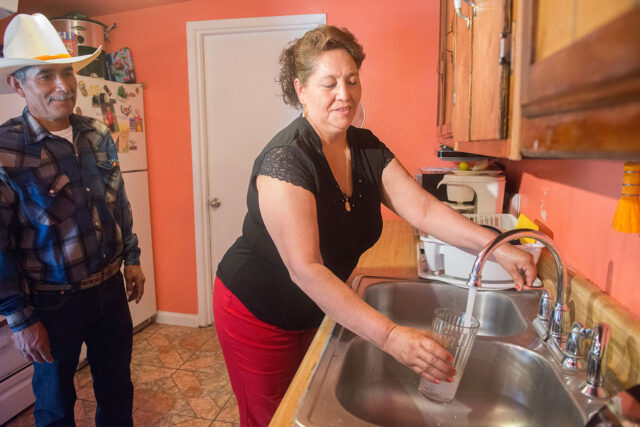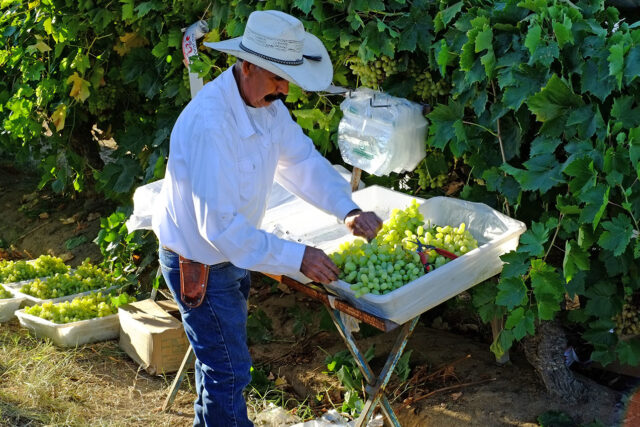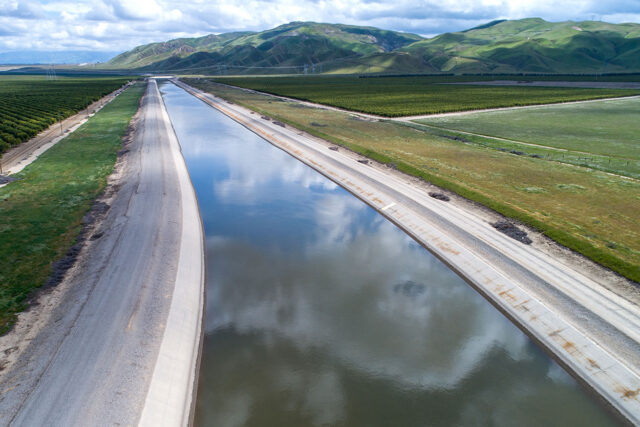Table of Contents
- Key Takeaways
- Introduction
- San Joaquin Cities and SGMA
- Urban Water Planning and SGMA in the Valley
- Land Use Planning Coordination: An Important Linchpin
- Opportunities for Beneficial Partnerships
- From Here to There: Water and Land Use Planning Recommendations
- Conclusion
- Notes and References
- Authors and Acknowledgments
- PPIC Board of Directors
- Water Policy Center Advisory Council
- Copyright
Key Takeaways
The San Joaquin Valley is ground zero for the Sustainable Groundwater Management Act (SGMA). It has the largest groundwater deficit in California and faces some of the worst impacts from overdraft, including land subsidence and drying wells. SGMA will help the region address these issues—while also building its climate resilience. But this will require hard work, not only by farmers—the largest groundwater users—but also by the valley’s urban water utilities, which serve a growing population while relying mostly on groundwater. As the valley confronts limits on groundwater pumping, urban utilities, local land use authorities, other water users, and state agencies must all engage to ensure a smooth transition for the region’s residents.
- SGMA’s timeline creates uncertainty for urban utilities. To lessen the costs, SGMA allows groundwater sustainability agencies (GSAs) 20 years to bring basins into balance. But if GSAs put off the hard decisions around establishing pumping allocations, this puts urban communities—which are required to demonstrate reliable long-term supplies for new development—at risk.
- Further reductions in per-capita water use can help communities adapt. Urban water use is relatively high in the valley, but per-capita water use has declined since the last drought, and there is potential for additional savings. These savings can help communities accommodate growth.
- Land use changes will play a critical role. Utilities and local land use authorities can team up to reduce outdoor water use—a major driver of urban demand—through land use changes. They can also work to protect areas suitable for groundwater recharge from development.
- Partnerships will help urban utilities address looming challenges. Local partnerships between urban communities and agriculture around groundwater recharge and water trading can keep water available and affordable for the valley’s urban residents and support solutions for small communities. State agencies also will play key roles in ensuring SGMA’s success.
Introduction
California’s Sustainable Groundwater Management Act (SGMA) is a 2014 law that requires local water users to bring groundwater basins into balance by the early 2040s and address negative consequences of groundwater overdraft along the way. The law will bring about major change in the San Joaquin Valley. Regional overdraft of roughly 2 million acre-feet per year—the largest in the state—is causing numerous costly problems, including dry wells, sinking lands, infrastructure damage, and reduced reserves for future use (Hanak et al. 2019). Restoring balance will require a combination of new water supply investments and programs to manage demand—all of which also entail costs.
To date, most work on the costs of SGMA compliance in this region has focused on agricultural groundwater users, who account for the vast majority of groundwater pumping. Yet most of the valley’s urban communities rely heavily on groundwater and accordingly face important SGMA challenges. As groundwater supply is constrained in the future, meeting the needs of a growing population will require new planning approaches. Land use decisions—including how new landscaping is developed and whether and where new groundwater recharge takes place—will influence the water demand trajectories and supply options that urban water utilities face. And against this backdrop, utilities will face continued pressure to maintain affordable rates in one of the state’s lower-income regions. For smaller urban utilities in particular, managing increased groundwater scarcity will require innovative solutions.
This report describes some of these challenges and explores opportunities for addressing them, including through partnerships with other water users. Such partnerships can support successful SGMA implementation while providing shared benefits for the valley’s urban residents and the region as a whole. Some partnerships that could tackle SGMA’s toughest challenges—such as drinking water reliability for smaller rural communities—may not initially appear to solve the urban water sector’s supply problems. However, in facilitating SGMA implementation, these partnerships can help secure the stable groundwater levels that the valley’s urban communities rely on in the long term.
In developing this analysis, we benefitted from input from a diverse group of valley stakeholders, including urban utility managers, local land use officials, and advocates for small communities, as well as state agencies involved in key water- and land-related policies and programs.
The first section of the report introduces some key challenges and risks that urban utilities face under SGMA. The subsequent section provides an overview of important elements of urban water planning in the valley. After looking at several baseline supply and demand indicators from the past few years, it then summarizes how utilities forecasted future demand and planned to meet it in their 2015 Urban Water Management Plans, and provides an early look at how the outlook has changed in the latest round of these plans, submitted in summer 2021. It also examines important drivers of residential demand, including the potential impacts of climate change; assesses the affordability of water rates; and explores issues raised in the first groundwater sustainability plans. The third section turns to the critical role that land use decisions play in reducing costs and uncertainty, highlighting important points for policy and planning integration. The report then lays out how partnerships between urban and agricultural users around groundwater recharge and water trading can help address urban systems’ challenges and improve supply reliability for small communities, drawing on experiences from California and elsewhere in the US. It concludes with recommendations that both local communities and the state could adopt to support successful pathways to SGMA compliance.
Several technical appendices provide additional information on urban water supply and demand issues (Technical Appendix A), detailed analysis of residential water use across four urban communities (Technical Appendix B), lessons from elsewhere in the US (Technical Appendix C), and a review of how water is integrated in a sample of San Joaquin Valley land use plans (Technical Appendix D).
San Joaquin Cities and SGMA
The valley’s urban centers can be described as “floating islands in a sea of agriculture” (Figure 1). Today, the region is home to roughly 4 million residents, who collectively account for just 3 percent of the region’s net water use (Hanak et al. 2019). But urban water demand could grow: the valley has been one of California’s fastest-growing regions for several decades, and its population is projected to grow by another million inhabitants by 2040 (California Department of Finance 2020).
Most of the region’s population (87%) is served by roughly 50 urban water utilities—a mix of municipal water departments, private utilities, and special districts. Most of these utilities rely entirely on groundwater for their water supply. In addition, several hundred small water systems that serve smaller towns and more dispersed, rural populations also rely on groundwater—as do tens of thousands of residents who depend on domestic wells for their drinking water. These small communities, which typically have shallower wells, already face greater risks of water quality violations as well as water shortages during drought, and they may face added challenges under SGMA.
The San Joaquin Valley’s urban centers are surrounded by farmland

SOURCE: Developed by PPIC using the Department of Water Resources 2016 land use layer.
NOTES: Large, mostly contiguous areas of farmland surround the valley’s urban areas. Other open space includes dryland areas and oilfields. White lines demarcate groundwater sub-basins subject to SGMA.
SGMA is in the early stages of implementation in the valley. Groundwater sustainability agencies (GSAs) submitted groundwater sustainability plans (GSPs) in 11 critically overdrafted basins in early 2020, and plans in several other priority basins are due to launch in early 2022 (Box 1). Many of the groundwater sustainability plans submitted in 2020 foresee supply expansion investments—and especially groundwater recharge—as a primary pathway to SGMA implementation. However, new controls on groundwater pumping are inevitable in the most severely overdrafted basins (Hanak et al. 2020), and these restrictions will intensify competition for water resources. For the valley’s urban water utilities in particular, this means navigating difficult trade-offs with agricultural interests that seek reliable groundwater resources, especially during droughts. This new challenge will emerge alongside increasing pressures to keep drinking water affordable while also securing adequate supplies to accommodate new residents and meet state mandates for housing construction.
The valley is home to most of the state’s critically overdrafted basins
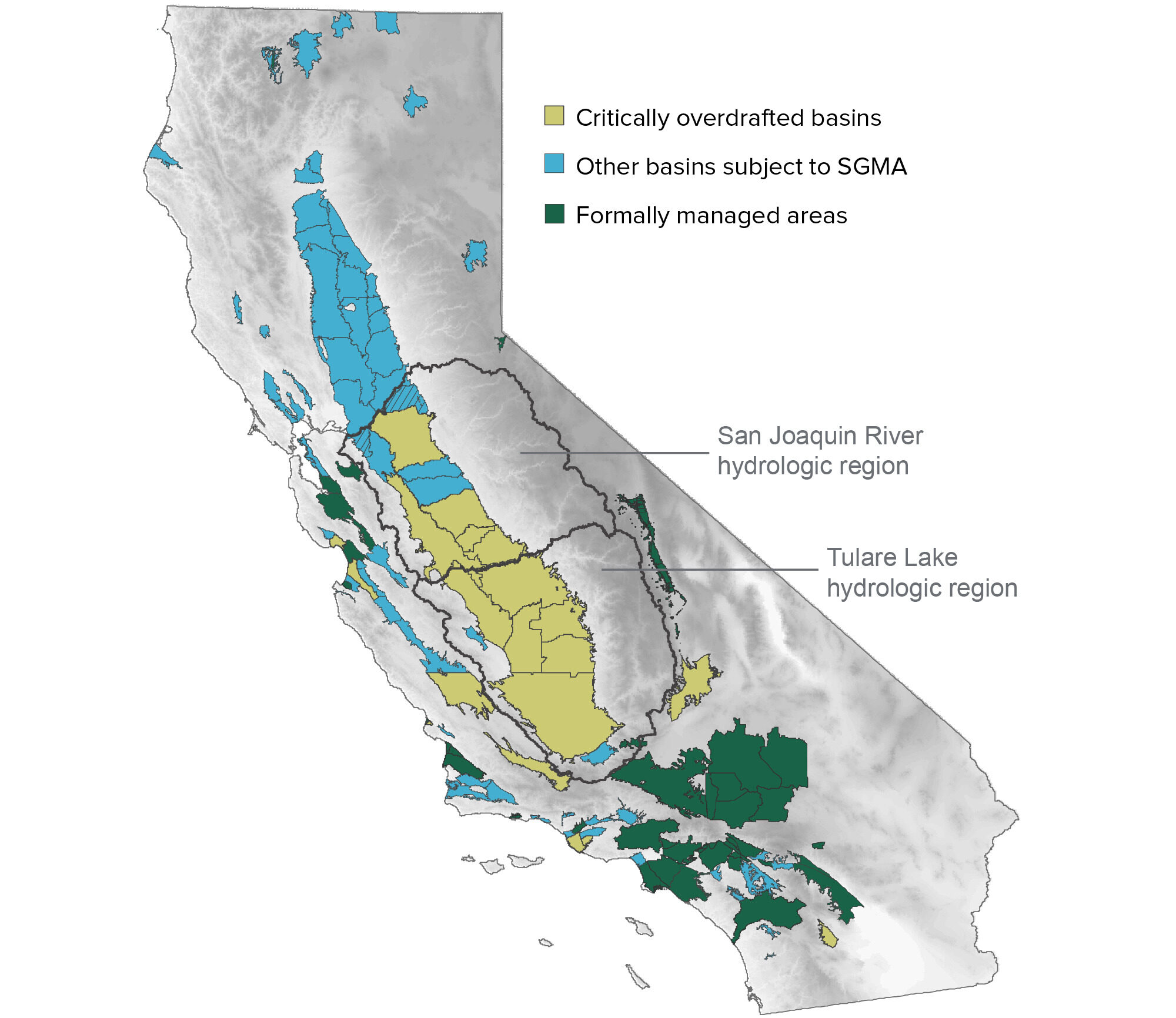
SOURCE: Developed by PPIC using basin and region delineations from the Department of Water Resources.
NOTES: This report focuses on urban areas within the two hydrologic regions outlined here. We excluded East Contra Costa and Cosumnes sub-basins (hatched in gray) because large urban areas outside the San Joaquin Valley (San Francisco Bay Area and Sacramento metro area, respectively) heavily influence their development trajectories.
SGMA implementation in each basin can entail risks and uncertainties for urban communities. Adopting a prolonged “glide path” approach to ending overdraft poses some risks because it increases how much “transitional” pumping (additional overdraft) can occur between now and the early 2040s. While this gradual approach can help to lessen compliance costs in the near term, it also can invite putting off hard decisions. A second issue involves whether (and how quickly) basin users move to quantify and allocate the volume of groundwater each water user can pump, and whether they do so together or in a piecemeal fashion. This is a key issue for urban utilities, which need to assure reliable supplies for new development. Finally, there is uncertainty about whether negotiations over groundwater management will send users to the courts—a potentially costly and protracted process. Resolving these uncertainties will be necessary for robust planning and investment decisions over the long term.
The valley’s urban communities can meet these challenges. Many communities have additional capacity to reduce per-capita water demands, building on a trend that has been underway for two decades. And importantly, some of the most promising supply strategies for urban areas can mesh well with the needs of other water users. This is especially true where additional groundwater recharge is cost effective. Agricultural interests often have access to water and land for recharge projects, while urban agencies can bring capital and long-term planning capacity. Such collaborative recharge arrangements may provide new revenue opportunities for those owning croplands that no longer can be irrigated in the future. When water resources become especially scarce during drought and all eyes turn to groundwater, urban purveyors can build upon innovative water transfer arrangements to facilitate reallocation that leaves all parties better off.
Finally, while urban utilities are not directly responsible for addressing the water supply vulnerabilities facing small rural communities, they can serve as important partners in such efforts. Larger utilities often possess the technical and administrative expertise to help resolve system operation issues in small water systems. Where consolidation is a good option, state funding is available to help cover the costs (Legislative Analyst’s Office 2020).
Urban Water Planning and SGMA in the Valley
Urban water suppliers have the difficult task of forecasting future demand in the face of great uncertainty, securing reliable supplies to serve those demands in both wet and dry years, and maintaining critical infrastructure to ensure continuous access to safe drinking water—all while keeping rates affordable. In evaluating the impact of SGMA on urban water utilities, it is important to understand how much additional demand they are likely to face and how SGMA will likely affect their projected supply portfolios. Future water use will depend on not only population growth but also patterns of development, policy choices, and the changing climate. Meanwhile, the supply sources available to utilities, and their costs, will depend in part on the actions taken by groundwater sustainability agencies. Raising rates to reflect rising costs and adopting new rate structures can help to constrain growth in water use and encourage conservation, but tracking the affordability of basic supplies will remain important.
In this section, we consider how urban water use and cost in the valley has been evolving. We draw on data from the 2015 and 2020 Urban Water Management Plans (UWMPs), water use and rates collected by the State Water Board, water use data from California Water Service Company (Cal Water), and other sources. We also inform these analyses with input from focus group discussions with urban water agencies, local governments, and other local and regional stakeholders.
Urban Water Use in the Valley is Evolving
A Rapidly Growing Region
The population of the San Joaquin Valley has burgeoned over the past few decades, growing by approximately one million people from 2000 to 2015. A similar increase in residents is projected from 2015 to 2040, which includes the first 20 years of groundwater sustainability plan implementation (Figure 3). High housing costs and a dearth of development along the coast is pushing urban development to spill over into the valley (especially in its northern reaches) and encouraging some individuals to relocate there to find cheaper housing. In addition, the fertility rate in valley counties is among the highest in the state (Department of Public Health 2021; Department of Finance 2021). The resulting growth will place upward pressure on water demands, even as the prospect of new groundwater development becomes more difficult.
The valley’s rapid population growth is projected to continue
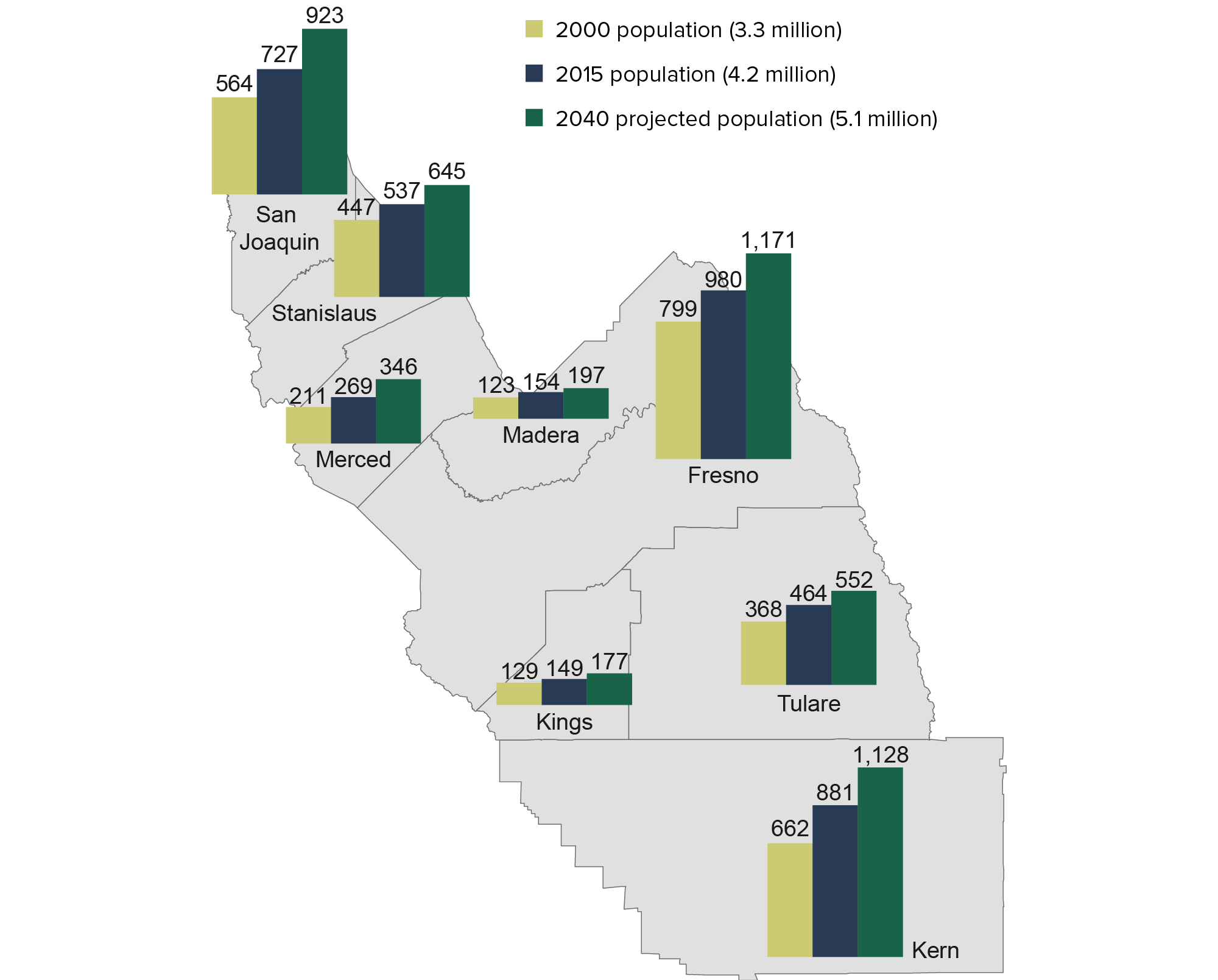
SOURCE: Year 2000 population estimates obtained from Decennial US Census data accessed through Social Explorer. Estimated (2015) and projected (2040) populations by county are from the California Department of Finance (March 2021).
NOTES: Numbers on bar charts are county population counts, in thousands of residents. Madera, Fresno, Tulare, and Kern each have small populations in the foothills and Sierra region, above the region’s main groundwater basins on the San Joaquin Valley floor, which are the focus of this report. Southeastern Kern County also has some residents in higher-elevation, groundwater-dependent areas, including Indian Valley Wells (a critically overdrafted basin under SGMA) and Antelope Valley (a recently adjudicated basin, exempt from SGMA).
High Dependence on Groundwater, Especially for Smaller Utilities
Most utilities rely on groundwater for at least a portion of their supplies, with a few exceptions (Figure 4, left). Larger utilities tend to utilize a mix of surface and groundwater, reflecting several decades of investments to install water treatment plants and purchase supplies from neighboring irrigation districts. In contrast, nearly all smaller urban utilities rely entirely on groundwater. Although addressing groundwater contaminants is currently causing costs to rise, groundwater systems have been relatively inexpensive to establish and maintain. While utilities with a history of incorporating surface water into their supply portfolios have the infrastructure and know-how to diversify, many other—especially smaller—utilities will face hurdles. Valley residents living in smaller communities outside of major utilities’ service territories almost always rely entirely on groundwater.
Groundwater reliance is prevalent, and water use is higher than the statewide average

SOURCE: Author calculations based on data from 2015 Urban Water Management Plans (population and groundwater share) and State Board (per-capita water use).
NOTE: Bubble sizes correspond to total population served in 2015. Groundwater reliance is the proportion of groundwater in the total water supply portfolio in 2015. Per-capita use is for January to December 2018 where complete data were available. For details, see Technical Appendix A.
High, But Declining, Per-Capita Water Use
With a rapidly growing population, ubiquitous groundwater reliance, and limits to expanding groundwater use as the valley implements SGMA, the region’s relatively high per-capita urban water use will need to change. Although there is quite a bit of variation, average daily per-capita use—184 gallons in 2018—lies far above the statewide average of 138 gallons, despite having fallen recently (Figure 4, right panel). (For more on per-capita water use and trends, see Figure 8 below and Technical Appendix A.) The southern valley experiences warmer temperatures and greater evapotranspiration from landscaping, which accordingly leads to higher water demands.
Low Water Rates
Per-capita use is high not only because it is hot, but also in part because water rates are relatively low: in comparing charges for 1,200 cubic feet (12 hcf) of monthly water service, the San Joaquin Valley stands out with a prevalence of cheaper bills (Figure 5). While low rates encourage more water use, they also help to ameliorate water affordability concerns in a relatively low-income region of the state.
Valley residents tend to face lower water rates than elsewhere in the state
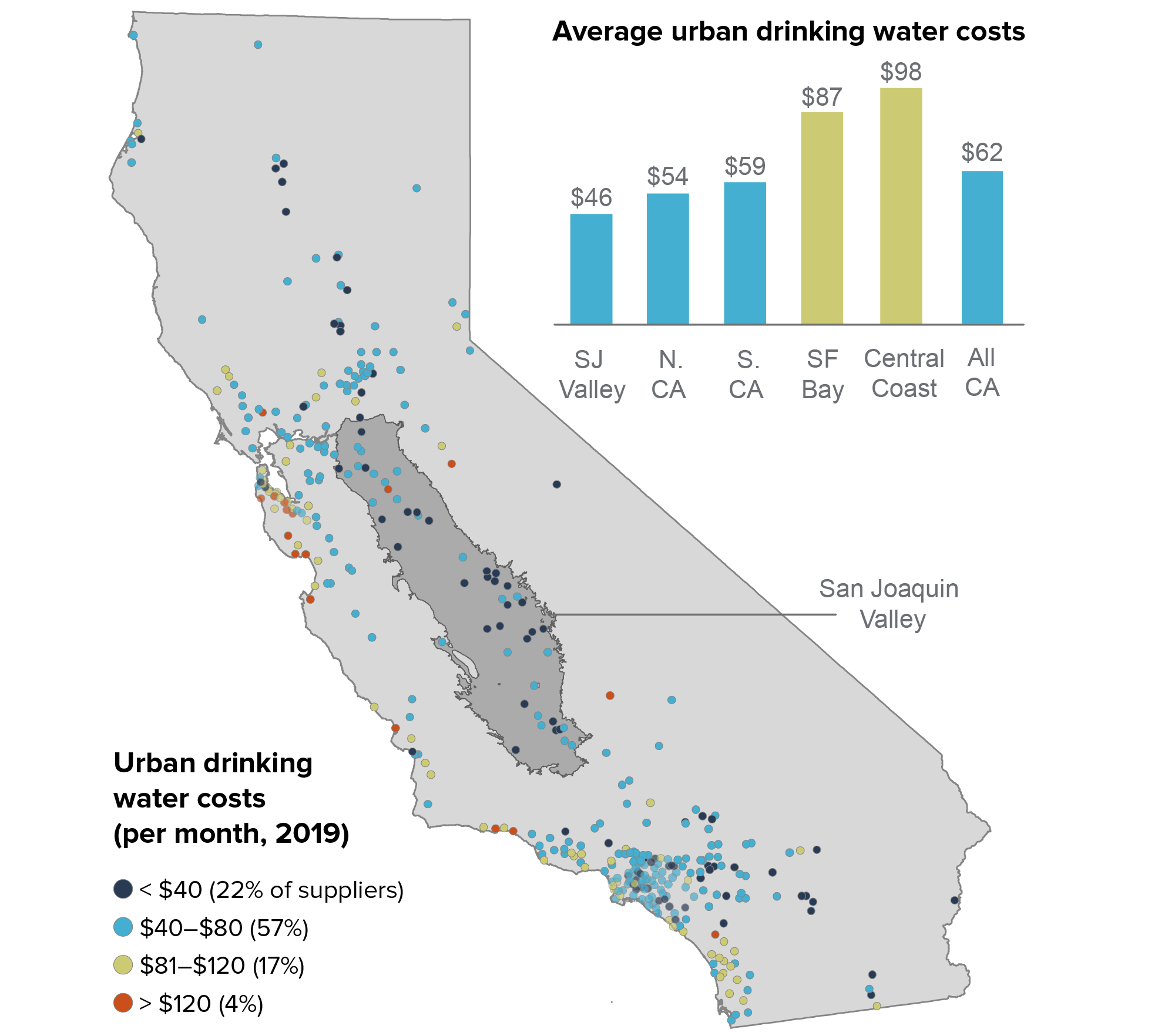
SOURCE: Mapped data from the 2019 State Water Board Electronic Annual Report (EAR) survey.
NOTE: Bills are calculated for a fixed service volume (1,200 cubic feet/month, or 100 gallons per capita per day for a typical household of three) that approximates average residential water use statewide. (Residential use is a subset of the total urban use reported in Figure 4.) All values in 2019 dollars. Regional designations are based on DWR hydrologic regions: Central Coast and SF Bay (San Francisco Bay Area) reflect their individual hydrologic regions; SJ Valley (San Joaquin Valley) includes the San Joaquin River and Tulare Lake hydrologic regions shown in Figure 2; S. CA (Southern California) includes the Colorado River, South Coast, and South Lahontan hydrologic regions; and N. CA (Northern California) includes the Sacramento River, North Lahontan, and North Coast hydrologic regions.
Late Adopters of Water Meters
Along with the Sacramento Valley, the San Joaquin Valley is one of the last regions in California to adopt widespread volumetric billing for water. In the early 2000s, more than half of the San Joaquin Valley’s urban utilities still had flat-rate systems, which charge customers the same amount regardless of their use (Hanak 2005). Spurred by federal and state legislation requiring the installation and use of meters, the picture has shifted considerably. Today, just a handful charge flat rates. The shift to metering and volumetric billing has likely provided a boost to water conservation. The widespread adoption of meters also puts valley utilities in a position to use pricing to encourage further demand reductions in a SGMA future. We discuss rate structures and affordability below, and in more detail in Technical Appendix A.
These supply, demand, and pricing characteristics lay the foundation for SGMA planning and implementation in urban areas. Continued rapid population growth will likely increase demand while SGMA constrains groundwater availability, the main source of supply for most urban communities in the region. At the same time, relatively high per-capita use and low prices suggest there may be opportunities to induce further conservation. In the next subsection, we look to the last round of Urban Water Management Plans (UWMPs), developed in 2015, to assess how utilities at the time expected to address their future supply and demand balances—and how these plans look when reduced groundwater availability is taken into account. We also assess the few 2020 UWMPs that were available at the time of this report’s writing in order to document the extent to which planning has evolved.
Pre-SGMA Views on Future Supplies and Demands
The most recent full set of UWMPs was compiled in 2015 and released in 2016; while technically released after the adoption of SGMA, most of the planning that went into them occurred prior to the legislation’s adoption and certainly prior to concerted efforts to form GSAs and plan for groundwater sustainability. As such, they represent a snapshot of pre-SGMA planning ideas: what may have been done absent the legislation. Broadly speaking, they suggest that valley utilities expected total water demands to increase substantially in the future. Consumption was projected to rise from approximately 682,000 acre-feet a year to over 1.25 million by 2035, a result of anticipated population growth and per-capita water use rebounding from drought lows. Most utilities (79%) projected increased per-capita use from 2015 to 2020 (see Technical Appendix A for more information).
Water Use Has Not Rebounded to Pre-Drought Levels
More recent data, however, reveal that per-capita water use has not rebounded to pre-drought levels. Accordingly, we updated existing forecasts using per-capita use from 2018; these updates suggest approximately 25 percent less future use than anticipated in 2015 (see Technical Appendix A and Figure A2). Total demand would still increase somewhat because of population growth, and many utilities planned to expand their supplies by pumping more groundwater—something that will be more difficult to do in a SGMA future.
Groundwater Restrictions Could Affect Future Supplies
To understand how future groundwater restrictions could alter the urban supply portfolio—and projected supply-demand balances—we constructed several scenarios. Here, we hold groundwater supply constant at levels reported in the 2015 UWMPs. On the demand side, we consider original plan projections as well as per-capita use rates from 2018 (Figure 6).
With no new pumping and the original UWMP estimates of demand growth, there would be an aggregate shortfall of around 100,000 acre-feet by 2035. If, in contrast, per-capita use remains at 2018 levels, available supplies would still exceed demand overall, but almost half of utilities—especially smaller ones—would see shortfalls.
Water demand and supply projections demonstrate potential for shortfalls
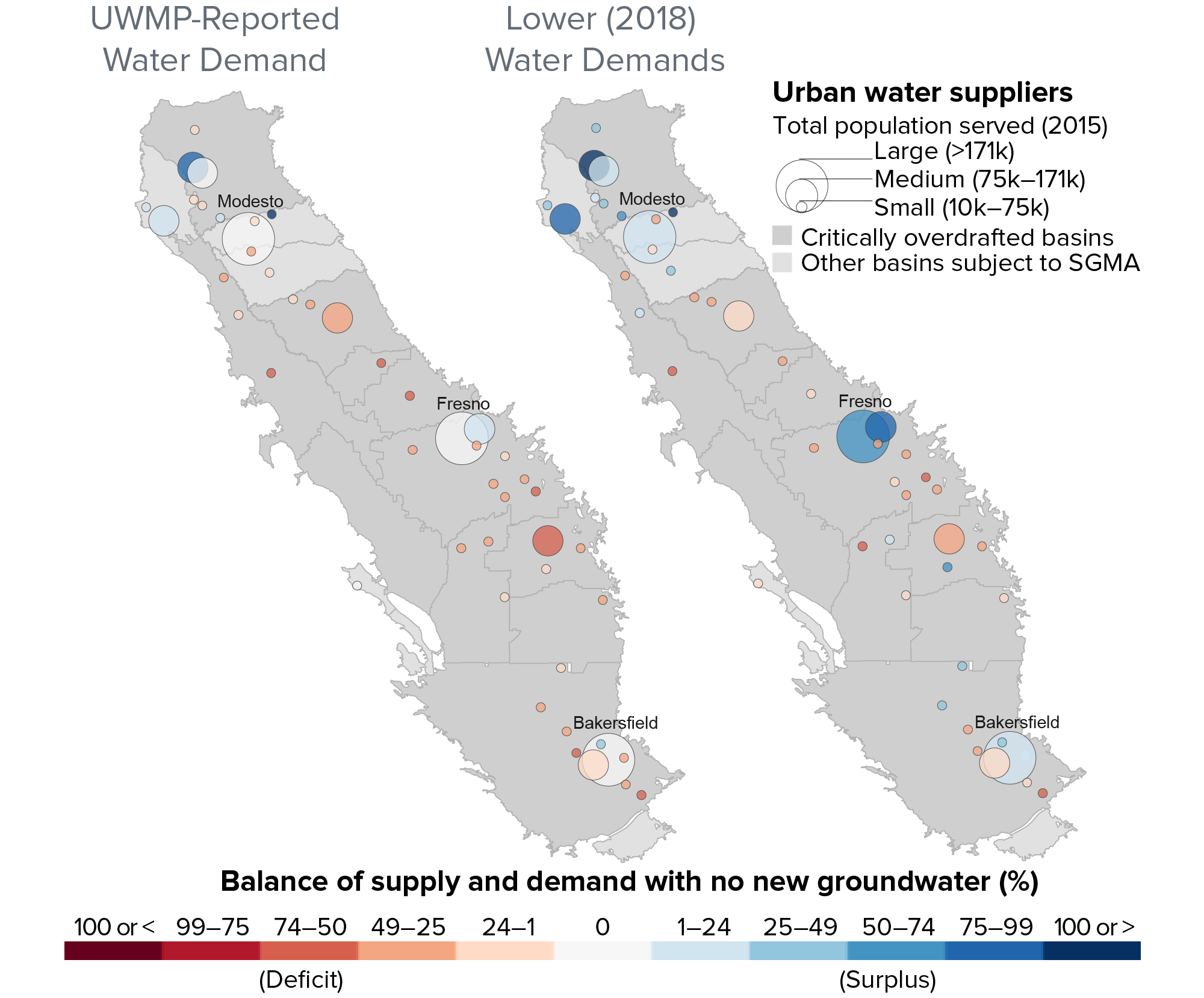
SOURCE: Author calculations based on 2015 UWMP projections and State Water Board water use reporting data for 2018.
NOTE: Calculated supply-demand surplus or shortfall in 2035 with no new groundwater relative to 2015 pumping. The valley faces an aggregate surplus in the right panel and an aggregate deficit in the left panel, but in both cases there is substantial variation across utilities. See Technical Appendix A for details.
In Technical Appendix A, we also consider scenarios with more extreme groundwater constraints, where pumping is cut back in proportion to the amount of overdraft in each basin. These scenarios correspond to a future in which water users within the basin are unable to augment supplies, and where urban communities are required to reduce pumping at the same rates that might be necessary for agriculture. As expected, greater pumping constraints would exacerbate supply shortfalls.
None of these scenarios is likely to occur as described. Yet they reveal that groundwater-dependent utilities in overdrafted basins face a real possibility of supply shortfalls unless they take action to acquire additional water resources or temper growth in water use. Groundwater resources certainly will become scarcer. While this may induce recharge to expand the groundwater pie, it also likely will prompt utility operators to reassess their supply mix. This analysis highlights the importance of accurate demand forecasts: numerous utilities transition from a deficit or near-deficit in their supply-demand balances to surpluses when updated per-capita use rates are taken into account. Given uncertainty around population growth and the numerous factors that influence household water use, regularly updating demand projections will be critical for planning the best SGMA response strategies.
Most Smaller Urban Utilities Projected Continued Groundwater Reliance
To understand how future portfolio development might vary across utilities, we also examined their projected supply mixes (Figure 7). Very few utilities planned to reduce groundwater reliance, and those that did were either (a) larger, better-resourced providers (e.g., Fresno, Bakersfield) or (b) some smaller ones in the wetter northern parts of the valley (e.g., Oakdale, Turlock). Most small suppliers are completely reliant on groundwater, and for many of them the costs of accessing and treating surface water would likely prohibit a shift away from groundwater. Multiple smaller utilities could collaborate and enjoy cost savings by co-investing in shared treatment infrastructure. But smaller suppliers also face administrative and technical capacity constraints that are complicating SGMA planning more generally, and they may be a hindrance here as well. State support to enhance the implementation capacity of smaller systems, or to facilitate consolidation of these systems into better-capitalized larger systems, could provide large benefits.
Most small urban utilities planned to maintain or expand groundwater reliance
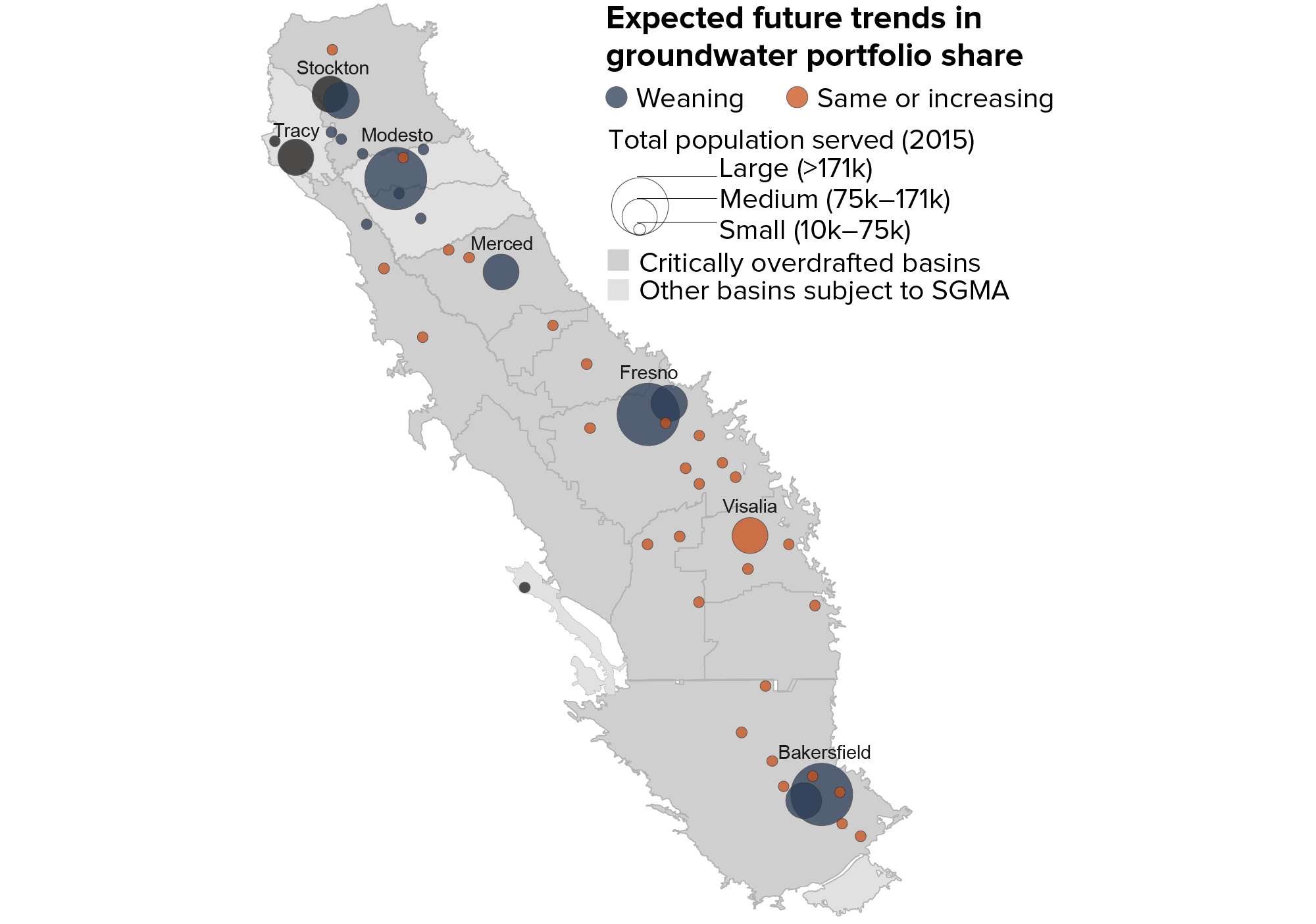
SOURCE: Author calculations based on 2015 UWMP projections.
NOTES: Coloring depicts urban utilities planning to increase/hold constant (red) or reduce groundwater reliance (blue) from 2015 to 2035, with reliance defined as groundwater supply as a proportion of total supplies. Many smaller urban utilities were already 100 percent groundwater reliant (Figure 4, left panel). Utilities depicted in dark gray were completely or nearly 100 percent surface water reliant and did not plan to change their mix appreciably. For more details, see Technical Appendix A.
Newest UWMPs Show Some Adjustments to SGMA, But More Work Lies Ahead
Utilities have been actively planning since they released these 2015 UWMPs. At the time of this report’s writing, 18 plans from the new round (2020) were publicly available. In these, we saw some evidence that utilities made adjustments on both the demand and the supply sides that could help them adapt to a future with SGMA. In the 2015 plans, 11 of the 18 utilities showed shortfalls by 2035 in our scenario with no new groundwater pumping (shown in Figure 6, left panel). In the 2020 plans, this number drops to six, and the deficits are now smaller, owing largely to expectations of lower per-capita water use, which almost all utilities reported as significantly lower relative to 2015. At the same time, fewer utilities anticipated substantially reducing their reliance on groundwater in the 2020 plans (5) than in the 2015 versions (9); of the four no longer planning reductions, two have access to surface water and have already achieved the reductions set out in their 2015 plans, while the other two are smaller utilities without surface water access. Finally, of the 30 utilities yet to submit 2020 plans, 25 projected supply shortfalls with no new groundwater in 2015—a much higher proportion than among those who have submitted. It is likely that those without access to surface water—in 2015, 21 of the 30—will deliver plans with similar outlooks this time around.
While restrictions on groundwater use will complicate supply planning, and perhaps stretch some utilities’ supply portfolios thin, recent reductions in per-capita water use have helped to lower projected deficits and may be sufficiently durable to temper long-term demand growth. Moreover, increased efforts to limit demand could go a long way toward avoiding costly supply expansion; just how far is the focus of the next subsection.
Demand Reduction: How Much More is Possible?
The UWMPs provide a coarse view of water supply planning in the valley. Population growth estimates and assumptions about per-capita use underlie their water demand forecasts. By using household-level data from one of the larger water suppliers in the valley, Cal Water, we can shed additional light on the drivers of demand—including estimates of how much water is used for landscaping and how warming temperatures may influence these patterns in the future. (For details, see Technical Appendix B.)
Cal Water has four urban service areas within the San Joaquin Valley: Stockton, Selma, Visalia, and Bakersfield. They vary in size from small (Selma; under 10,000 connections) to large (Bakersfield; more than 75,000 connections) and range from the northern (Stockton) to southern (Bakersfield) parts of the valley, with Selma and Visalia in between. In Bakersfield and Stockton, Cal Water is not the sole water provider, but it serves the majority of the population.
Total household water use has declined significantly in all four service areas (Figure 8). The declines are larger in the three southern districts than in Stockton, which in part reflects the impacts of metering. Only Stockton was fully metered over this whole period; meters were introduced elsewhere starting in 2009. But the patterns are also consistent with higher outdoor water use in these three districts, especially from the late spring through early fall—reflecting increased landscaping demands during the dry season, when temperatures are also hotter.
Household water use has declined across the valley’s Cal Water service areas, especially in summer months

SOURCE: Author calculations using data from Cal Water’s systems in the San Joaquin Valley.
NOTE: Illustrations of seasonal per-household water use for single-family households in each of Cal Water’s valley service areas. More information in Technical Appendix B.
Although Landscape Water Use Has Fallen, It Is Still Substantial . . .
Outdoor water use, primarily to irrigate landscaping, drives much municipal water use. It makes up about half statewide, and a similar share within the valley. Accordingly, this an important area of focus for urban utilities as they seek to manage water demand.
The patterns of monthly water use in Figure 8 roughly illustrate the role of outdoor water use, which is not typically metered separately from indoor use. To shed further light on how landscape water use varies across the Cal Water service areas over the 2011–19 period, we used a regression-based approach (for details, see Technical Appendix B).
This analysis reveals significant variation by season (winter and summer), location (southern versus northern areas), and year. In Stockton, average annual water use per acre of landscape over this period (around 10 inches) is about one-quarter of that in Bakersfield (around 42 inches). While much outdoor water use occurs in summer (June to September), as one moves farther south, this proportion declines, likely because shoulder-season irrigation in spring and fall is increasingly important. (Summer use represents about 70 percent of use in Stockton versus half in Bakersfield.) Finally, although outdoor water use varies across years due to precipitation and moisture conditions, drought conservation measures in 2014 and 2015 reduced it significantly, and these changes have mostly persisted.
. . . But Urban Areas Use Less Water per Acre than Irrigated Cropland
In this heavily agricultural region, urban development often entails conversion of farmland around existing communities (see Figure 1). One question in the SGMA era is whether this transition can substantially reduce total water use and contribute to balancing basin supplies with demand. The answer depends on two key factors: how the intensity of water use on landscaped area compares with that of irrigated cropland, and how much landscaping there is in the total urban footprint. Looking just at landscaped area, the water applied per acre annually in Bakersfield (approximately 3 to 3.5 acre-feet) implies an almost 1:1 conversion between agriculture and urban landscaping. But taking into account the substantial hardscape in urban development (buildings, pavement, roads, etc.), per-acre water use for a representative Bakersfield parcel falls to just a third of what is typically used on crops. In valley communities further north, where landscape irrigation uses less water per acre, urban development is likely to compare even more favorably to farmland in terms of water use. This suggests that urban development could indeed improve a basin’s water balance—provided that it results in a net decline in irrigated crop acreage, and not just a shift in its location.
The Valley Still Has Opportunities to Reduce Landscape Water Use
Valley cities could further reduce landscape water use by replacing turf and adopting other efficiency measures. A state initiative, the Model Water Efficient Landscape Ordinance (MWELO), sets a standard for outdoor water use in new developments. In particular, the standard suggests that water use should not exceed 55 percent of “reference evapotranspiration,” or the amount of water required to maintain green grass landscaping. While average outdoor use in Stockton and Selma is already consistent with this standard, Visalia (around 65%) and Bakersfield (around 80%) exceed it. If the single-family residential homes in our sample could reduce average outdoor water use to the 55 percent standard, Visalia and Bakersfield could save around 1,200 and 3,750 acre-feet per year (roughly 5% and 7% of 2015 water use), respectively. Attaining the standard on all urban landscapes could save more. New budget-based outdoor water efficiency standards under consideration at the state level may also move utilities towards even more ambitious landscape efficiency initiatives; in contrast to MWELO, which just applies to new development, the new standards will apply to all residential landscaped area.
These savings could help water agencies facing deficits turn the balance sheet around, despite reduced pumping under SGMA. But attaining the standard on developments built before MWELO can be costly and not always pencil out for individual homeowners. To finance these transitions, municipalities could institute water supply development fees for new construction; they require developers to provide either funding or water to support the development. (Such fees are described later in the report and in Technical Appendix C.) Such funding could help pay for the transition of older landscapes—with the conserved water credited towards the new development.
How a Changing Climate Might Affect Future Water Demand
The results discussed above highlight how decisions made today can affect demand and scarcity into the future, even if climatic conditions remained the same. However, the climate is changing. During the same timeframe when SGMA is likely to restrict groundwater access, average temperatures will continue to rise (Bedsworth et al. 2018; He et al. 2018), potentially raising demand. Climate projections are less certain about whether average precipitation will change, but a future with more frequent droughts is also a possibility. Accordingly, it is useful to understand how changes in temperature and precipitation drive urban water use across the valley.
Seasonality and location clearly play a role in determining water use, but a simple comparison between winter and summer, or between the wetter northern parts of the valley and its southern reaches, will not reveal the effects of systematic weather changes in a particular location. Using over 6 million household-month observations of water use and weather conditions across Cal Water’s four service areas, we estimated the impact of incremental changes in weather on household water use. (For details see Technical Appendix B; Table B1 summarizes impacts.)
Overall, household adaptations to temperature and precipitation changes appear modest. Across service areas, an increase in monthly temperature of roughly 2 to 3 degrees Fahrenheit (approximately one standard deviation) is associated with an increase of between 1.5 and 4.5 percent of average monthly water use. The estimated impacts fall on the higher side of this range in Stockton, which lies in the valley’s wetter northern region. Increases associated with unusually low precipitation are slightly smaller but of similar magnitude. These results suggest that by the middle of the century, projected warming in this region could increase annual household water use between 2 and 7 percent across service areas unless consumers make landscaping changes, such as smaller irrigated footprints and more drought-tolerant plants. And if the climate also becomes drier, this could place additional pressures on water demand.
Implications for Water and Land Use Planning
Numerous factors will affect how urban water demands develop over the SGMA time horizon. Our analysis suggests that San Joaquin Valley utilities facing restrictions on groundwater access should be cognizant of two factors: landscape design in current and future development, and climate change. Utilities can do little to control the latter, but they do have some influence over the former: they can collaborate with local land use planners, give input on state-level landscaping ordinances, and design procedures to assess available supply for new development. We discuss these important linkages with land use planning later in the report. In some cases, investments to address landscape water use may simultaneously boost resilience to climate warming trends.
Water Rates and Affordability
Maintaining affordability also complicates the picture for utilities, which will need to pass on the costs of new supply projects and incentive programs to encourage outdoor demand management—such as turf rebate programs. Utilities across California are also spending more for infrastructure upgrades to maintain water quality—an ongoing issue in many valley communities. As costs rise, utilities need to consider how to keep water affordable for their customers. This is especially important for basic water services—water for drinking, cooking, sanitation, and other indoor needs.
Balancing Trade-Offs in Rate Design
Designing rates to maintain financial stability, keep prices low for basic needs, and encourage conservation through volumetric charges has always been a challenging balancing act (Hall 2009; Hanak et al. 2011). Most water system costs do not vary with the amount of water sold. As a result, utilities that charge a large proportion of their bills by volume—important for incentivizing conservation—can encounter challenges in covering their fixed costs during times of drought, when they ask customers to save more water. Publicly owned water utilities in California face an additional constraint: Proposition 218, which restricts water-related fees to the costs of providing service to a property and requires votes for other charges. Drought surcharges can maintain fiscal solvency during dry times and signal increasing scarcity, but Proposition 218 restrictions can make these surcharges difficult to adopt.
Rates, Incomes, and the Burden of Water Bills
Assessing whether rates in the valley provide for broadly affordable water is especially important given the prevalence of valley communities with relatively low incomes. We explored this issue by estimating the share of median household income needed to cover water service of approximately 150 gallons per day—or roughly 50 gallons per person for the average three-person household. This is one metric of community-level (un)affordability that the state has been considering in its assessment of water affordability challenges (State Water Resources Control Board 2021).
Valley-wide, the cost of this basic water service exceeds 1.5 percent of median household income for approximately 9 percent of Census block groups. In some block groups, basic water service takes up as much as 4 percent of median income. (Details of our analysis are in Technical Appendix A; Figure A6 presents the full distribution.) Figure 9 illustrates how affordability concerns vary within a selected set of valley water systems by mapping this metric for a mix of urban utilities in Fresno, Tulare, and Kings Counties. Variation in pricing across utilities explains some affordability concerns—with monthly charges for basic water service ranging from less than $10 in Hanford to nearly $40 in Corcoran. But income variation within service areas is equally, if not more, important: while basic service appears generally affordable, some low-income neighborhoods in larger communities like Fresno face a much higher bill burden.
Affordability concerns vary within and across service areas
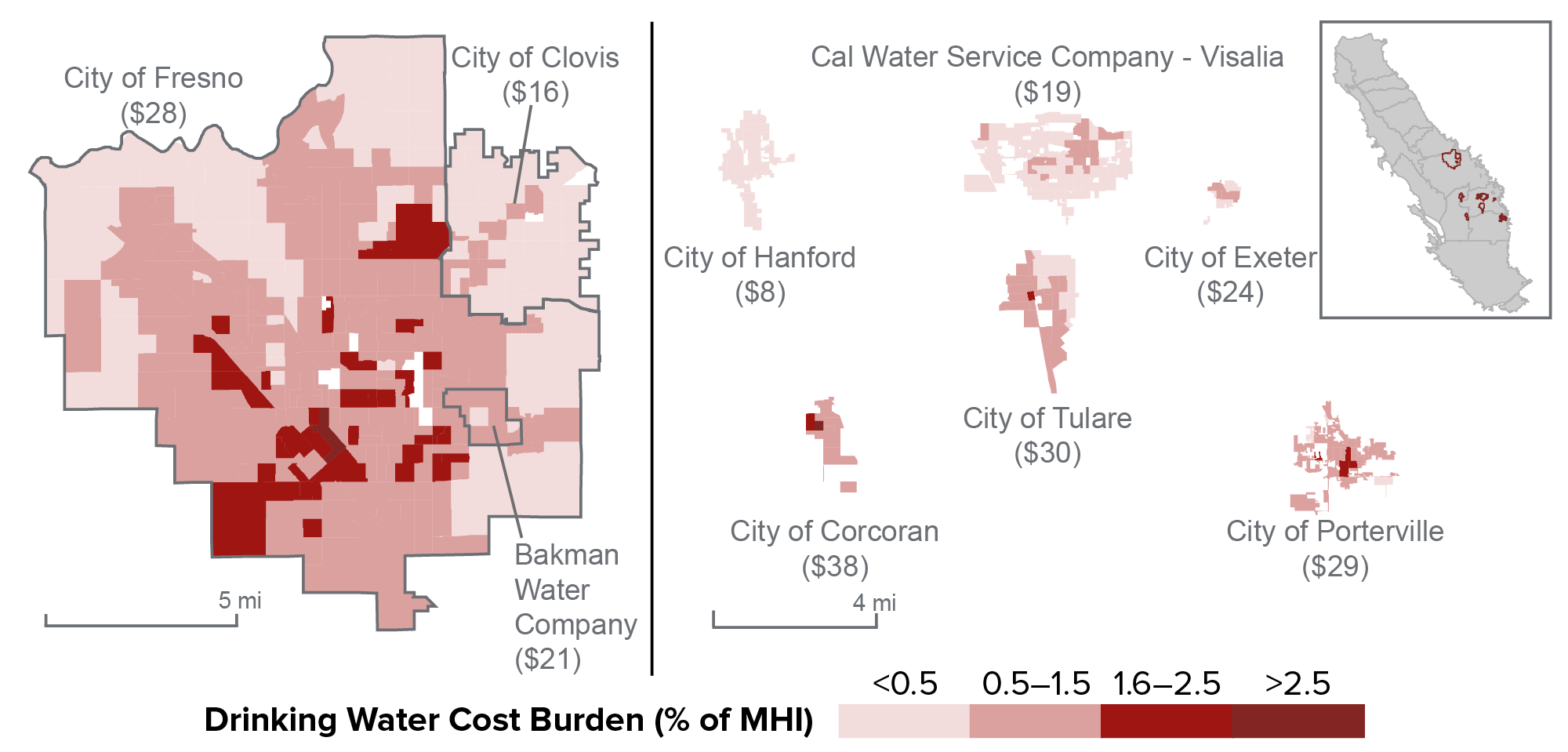
SOURCES: Author calculations using data from the 2019 State Water Board EAR survey (water bills) and the 2018 American Community Survey (median income). See Technical Appendix A for details.
NOTES: Numbers in parentheses show monthly water bills by utility service area for 6 hcf/month (roughly 150 gallons per day). Coloration indicates the proportion of median household income (MHI) in each block group that would be taken up by this bill level. Block groups typically have between 250 and 550 housing units. The left panel presents Fresno and Clovis, with their three water utility service areas, and the right panel a selection of service areas in Kings and Tulare counties.
Overall, the valley’s relatively inexpensive water service by statewide standards (see Figure 5 above) helps avoid high bill burdens for basic water service. Yet hot spots do arise, particularly in low-income areas: income is a major driver of bill burden variation within the valley. (For details, see Figure A7 in Technical Appendix A.) Higher bill burdens are also associated with utilities that still have flat water rates. By charging everyone the same total amount regardless of how much water they use, these rate structures do not allow users of small volumes to benefit from low volumetric charges.
Proposition 218 requirements constrain the ability of publicly owned utilities to offer explicit financial assistance programs for low-income customers, such as the lifeline rate programs that are common in the energy sector. Nonetheless, utilities can adapt rate structures to help maintain the affordability of basic water service. In particular, recouping more of the fixed costs of water service through volumetric charges (rather than through fixed monthly service charges) helps keep the cost of basic water service down, while incentivizing conservation. But affordability is still likely to be a growing concern as utilities face higher costs to maintain water quality and augment supplies where SGMA may constrain groundwater access. Another affordability concern for both urban and smaller rural water systems is the potential local economic fallout as farmlands are taken out of production, given the importance of agriculture and related industries like food and beverage processing in the region’s economy and employment. This makes finding cost-effective solutions for maintaining water service, along with supply partnerships with agriculture and small rural communities, top priorities—something we discuss below.
Balancing Supply and Demand Under SGMA
Urban water supplies may stretch farther than utilities projected back in 2015. Although the valley faces future restrictions in groundwater availability, per-capita water use has declined markedly since then. When we account for these declines, we find that aggregate urban supplies should exceed projected use over the SGMA implementation time horizon. This is true if utilities do not expand groundwater pumping beyond 2015 levels, and even if they had to implement the proportional reductions in groundwater pumping—alongside agricultural water users—that may be needed to balance groundwater basins. However, the aggregate numbers veil substantial variation; some utilities—especially smaller ones that rely on groundwater—may need to close a large gap by either ramping up efficiency or acquiring new supplies. The available 2020 UWMPs reveal that some utilities still have work to do on this front.
While there is opportunity for further urban demand management, continued progress is not guaranteed without concerted effort. Future consumption will depend primarily on population increases, which are coming to the valley. Decisions about the future of thirsty landscaping will also play a role: residents and businesses can adjust landscapes in response to drought, but prompting this change can require effort and significant coordination (e.g., through utility pricing and incentive programs or state and local conservation and landscaping mandates). Over time, such efforts can foster larger changes as well—as evidenced by the longer-term declines in outdoor water use in Cal Water’s service areas. Finally, the valley’s warming climate may boost residential demand, especially in the wetter northern areas. Nonetheless, reductions in per-capita use may be the least costly option for some communities that need to balance demand with available supply.
For some utilities, acquiring new supplies may entail shifting portfolio mixes toward surface water. Not many planned to do so in the 2015 round of UWMPs, and this may only be straightforward for those with conveyance connections and treatment infrastructure. For smaller urban utilities, shifting to surface water can present a challenge; some of them have not begun extensive SGMA planning and may lack connections to surface water. Smaller urban utilities may also face greater constraints in keeping water affordable, because they will not benefit from the same economies of scale enjoyed by larger utilities. Interconnection to larger systems is one path forward, but regional collaboration among smaller utilities on joint surface water investments can also provide flexibility and scale.
Insights from Early SGMA Planning
Groundwater sustainability agencies (GSAs) are the new local agencies in charge of SGMA planning and implementation, and their priorities will influence which options are available and how much the transition to sustainability will ultimately cost. Individual utilities will generally work jointly with other parties in this process. The new local governance structures could enable new partnerships and collaboration. But parties will also need to resolve differences, both within and across GSA lines, when they have differing views of the best path forward.
So far, the picture that emerges from the first GSPs for the region’s critically overdrafted basins, submitted in early 2020, suggests that urban utilities are focusing on different types of projects and actions than other (mainly agricultural) agencies (Figure 10). Agricultural projects emphasize expanding water supplies—particularly through new groundwater recharge. In contrast, most urban projects envision filling the groundwater gap by shifting surface water to cities from other current uses—by bringing more surface water treatment online to put existing water contracts to use, buying surface water from other parties, or increasing the use of recycled wastewater. Neither cities nor farms envisage significant demand management.
Urban agencies emphasize different approaches than agricultural agencies in GSPs
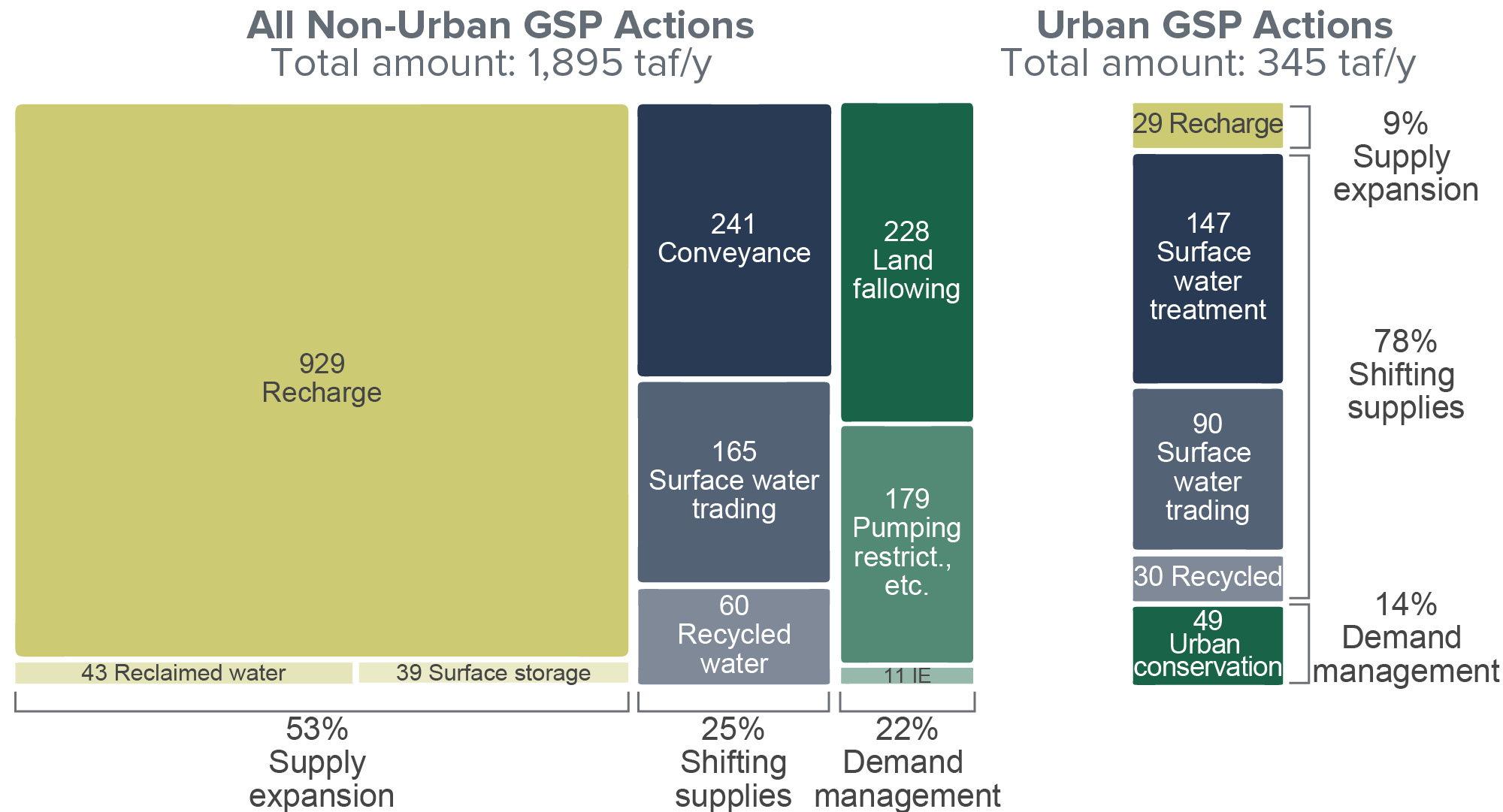
SOURCE: Author calculations, drawing on PPIC’s San Joaquin Valley GSP Supply and Demand Projects dataset.
NOTES: The figure shows the focus of planned projects and actions in GSPs for 10 of the valley’s critically overdrafted basins. (Merced’s GSP did not report volumes associated with its projects.) Urban actions (right) planned by 25 agencies are drawn from 22 GSPs, out of a total of 36. Actions are categorized according to their descriptions in the GSP; urban actions primarily or significantly benefit urban areas. Volumes are in thousands of acre-feet per year.
Earlier PPIC analysis suggests that while any individual project may be well-founded, the plans as a whole appear unrealistic for the region (Hanak et al. 2020). For one thing, they are counting too heavily on expanding supplies relative to amount of water that is likely to be available for recharge. In addition, the gains to one planning area from shifting in more surface supplies are not counted as corresponding losses from shifting water out of other areas. By counting the same drops of water multiple times as new supplies, the plans are underestimating the extent to which demand management will likely be necessary to bring overdrafted basins into balance. For these reasons, we anticipate that both urban and agricultural parties may come to reassess the role of demand management; for urban utilities, reducing landscape irrigation offers substantial cost-effective opportunities to reduce demand.
On the supply side, partnerships may help parties reap the most benefits from available opportunities. Some urban utilities will be in a financial position to bring more surface water into the mix, even if this causes corresponding reductions in water available for farming. Yet as we discuss below, there are ways to manage these shifts so that agriculture also benefits. And while recharge is one of the most cost-effective options for expanding supplies in the region, some projects may be too expensive for agriculture to finance alone—again suggesting a role for urban-agriculture partnerships.
SGMA Implementation Risks
The GSP process also contains certain risks for urban utilities hoping to lay long-term plans.
First, SGMA allows GSAs to take up to 20 years to attain sustainability. The possibility that GSAs adopt long glide paths can complicate planning for utilities if the pumping reductions that are ultimately necessary turn out to be quite different from those originally envisioned. Abrupt adjustments late in the process could be quite costly, especially if the responsibility falls on urban users to make expensive new investments.
Second, the valley’s GSPs place a strong emphasis on recharge, but there is not enough water to fuel it all (Hanak et al. 2020). If conflict over water for recharge (or over scarce groundwater resources when water for recharge does not materialize) is severe enough, adjudication or other legal proceedings may be necessary. Beyond generating financial costs, these efforts can also delay action: the average time needed to complete previous groundwater adjudications in California is eight years, and many lasted longer than 12 years. These efforts are ultimately valuable in that they help manage demand and clarify who has rights to what. But full-scale basin adjudication is a costly route; it may be avoidable in basins where GSA-led initiatives specify acceptable sharing arrangements without involving the courts. Box 2 describes the nature of groundwater rights that urban systems hold and how courts may view them in the context of a SGMA-related adjudication.
Land Use Planning Coordination: An Important Linchpin
Landscape irrigation plays an important role in urban water use, and it highlights the strong physical linkages between water and land use. Here, we explore the legal linkages. Rules about land use and development affect water resources, and rules constraining water use can make certain land uses more or less attractive. These linkages can also affect water supply, since paving and other development actions can eliminate land suitable for groundwater recharge. Urban land use decisions, rules, and plans will affect SGMA implementation, and vice versa.
Planning Integration at the Local Level
Cities and counties are the frontline entities responsible for land use planning in California, and state law requires they develop comprehensive plans and update them every 10 years. Although the plans are not required to contain a “water element,” they lay out a vision for land use that can have numerous implications for medium- to long-term water demand and supply.
Our review of general plans for all eight valley counties and 16 cities revealed that while water issues feature prominently compared to some western regions, tighter connections are needed. Although all 24 plans consider water resources, many do not directly address drought, climate change, or the water impacts of other hazards such as wildfire. Only some discuss processes to ensure adequate water availability to support development. As cities and counties update these plans, they should integrate issues related to SGMA implementation—including reducing landscape water demand and protecting areas for groundwater recharge.
State Policy Compatibilities
Beyond general plan requirements, a suite of state laws and policies has implications for the local water-land connection:
- Model Water Efficient Landscape Ordinance (MWELO). As described above, this law sets and periodically updates standards for outdoor water use in new developments. MWELO acts as a floor for local requirements, which is more likely to apply in communities lacking strong support for such regulations. MWELO is a requirement for city and county planning departments, which authorize new developments, not the water utilities that serve them.
- Water supply assessments (WSA). Since 2001, California’s “show me the water” laws require new developments that exceed a certain size (500 residential units or a more than 10 percent expansion of local water demand) to obtain a water supply assessment from the local utility that shows adequate water will be available to supply the new development in normal and drought times (Hanak 2010).
- Regional Housing Needs Allocation (RHNA). This policy sets housing construction targets at different levels of affordability for cities and counties across California, which must be incorporated into local general plans’ housing elements.
Whereas MWELO fully complements the goals of SGMA implementation, our focus group discussions revealed some stakeholder concerns about how the WSA and RHNA processes might interact with SGMA.
Providing Water Supply Assurances for Development May Require Allocations
Water supply assessments are a tool for ensuring that new development has a reliable and durable source of water before a community authorizes long-term housing investments; they are intended to protect new homeowners as well as the community already in place. But as SGMA makes some future groundwater availability less certain, this can also make it more challenging for utilities to issue WSAs. Thus the interests of urban utilities may diverge from agricultural interests in some basins: while many growers may prefer to forgo firm pumping allocations in favor of a slow glide path to sustainability, groundwater-reliant urban utilities will be interested in greater certainty. Setting pumping allocations—and devising a clear timeline for transitioning to sustainability—can put utilities on a firmer footing as they plan for the future. Success here can also facilitate the land use planning process, as cities and counties look to obtain WSAs needed for new development.
Meeting Housing Targets Requires Water
RHNA intends to promote the development of new housing in a state where there is widespread concern about housing costs. Communities that fail to meet RHNA targets can face legal and financial penalties (Association of Bay Area Governments 2020). In practice, however, communities rarely meet RHNA targets, in the valley or elsewhere in the state. Data for the most recent cycle, covering 2014–21 targets, show that no valley county had attained 50 percent of the targets in any price category; they achieved lower proportions for low-income housing (Department of Housing and Community Development 2020). The next cycle of RHNA is likely to require even higher targets to address widespread public interest in housing expansion.
Some valley stakeholders expressed concern that the pressure to build more housing could complicate SGMA implementation, since this would increase residential water demands just as water supply becomes scarcer. RHNA target-setting might benefit from increased consideration of how water supply constraints are likely to develop over the next 20 years. However, the valley’s urban utilities have already projected and planned for significant population growth. And as we’ve seen, utilities can meet SGMA requirements while accommodating housing expansion by continuing to promote water use efficiency and by forging partnerships with agricultural users to purchase water and develop new supplies. State actions that facilitate SGMA demand and supply solutions (e.g., water market development, new recharge opportunities) could help to resolve remaining tensions.
Protecting Areas for Recharge
Although valley GSPs likely overstate the potential for recharge, this solution remains one of the region’s best hopes for bringing in new supplies. But some projects may prove unworkable, or at least more costly, if municipalities pave over key recharge areas in the near future. Utilities and their partners need to set aside land for recharge, especially if they are planning to tap floodwater as a new supply source.
It is important to begin planning today for how to protect lands suitable for recharge that lie within urban spheres of influence. Especially on the east side of the valley, where GSAs are eyeing local rivers as a major source of recharge, urban areas are surrounded by large proportions of highly suitable recharge land (Figure 11).
Many urban areas in the valley are surrounded by lands suitable for groundwater recharge
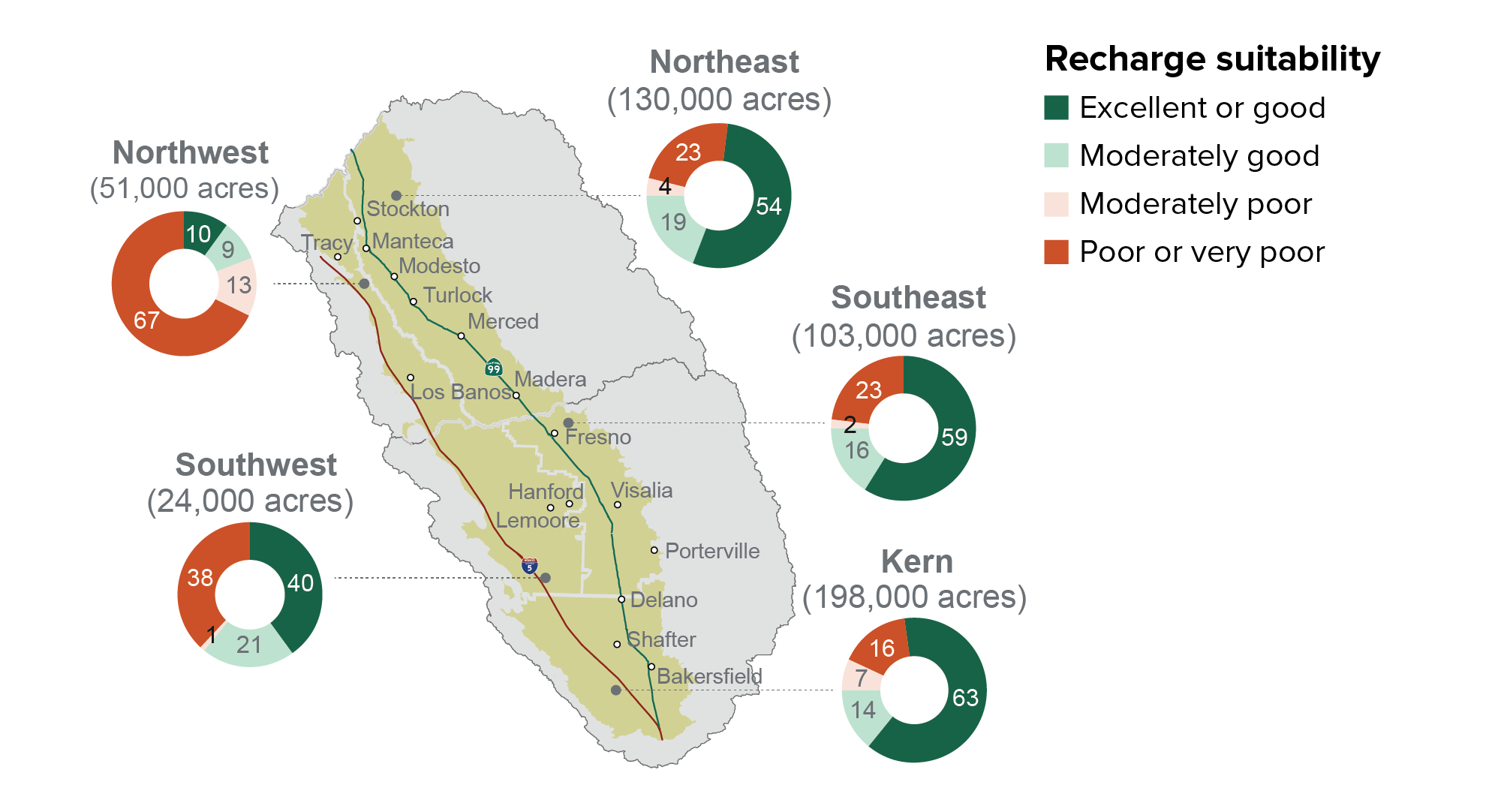
SOURCE: Jezdimirovic (2018). Mapped using data from the UC Davis Soil Agricultural Groundwater Banking index (SAGBI) (recharge suitability, assuming deep tillage) and the San Joaquin Valley Greenprint (urban spheres of influence).
NOTE: The map shows the proportion of land within urban spheres of influence that falls within each recharge suitability category.
Utilities should work proactively with GSAs and local governments to manage the threat of paving over land suitable for recharge. This may involve actively engaging in local planning processes, acquiring land for dedicated recharge (where it is likely to occur regularly), or contracting with agricultural or other landholders to provide space for flood recharge when supplies are intermittently available. Some urban water suppliers have worked with irrigation districts in the past to implement recharge projects (see the next section for some examples), and developing collaborations to identify and preserve land for recharge may be an important next step in SGMA implementation. Some stakeholders were concerned that municipalities are overlooking the importance of certain lands for recharge in their development decisions. One participant even suggested that proposed “green belt” initiatives, designed to preserve undeveloped (often agricultural) lands around urban areas, be expanded to include “blue belt” lands, acknowledging the importance that dedicated recharge land may play in the future of sustainable valley cities.
Opportunities for Beneficial Partnerships
No single entity or sector can implement SGMA alone, and urban utilities must implement partnerships with other water users within the basin. Three areas stand out where partnerships can provide mutual benefits and advance specific SGMA goals: recharge, water trading, and solutions for small rural communities.
Recharge
To date, urban utilities have been less active than agriculture in implementing recharge projects. But, as recharge projects rise in priority among valley water managers, agriculture and urban utilities may find opportunities to combine forces. Agricultural partners often have readier access to suitable recharge lands and water. Even when they cannot bring such assets to the table, urban utilities may be able to contribute funding to help move projects forward.
Some examples illustrate how these collaborations can take shape. The City of Fresno has several recharge sites within its service area. At its 200-acre “Leaky Acres” spreading grounds, water is delivered using canal infrastructure owned by the Fresno Irrigation District. In part, this recharge helps make up for the percolation lost due to the impermeable pavement covering much of the city. The City of Tulare shares ownership of a recharge basin with the nearby Tulare Irrigation District. It purchases water for percolation, and—although the site itself is not located within the city’s service area—the groundwater flow benefits its extraction wells. And the Arvin Community Service District—which serves the low-income community of Arvin—has entered into an agreement with the neighboring Arvin-Edison Water Storage District that will enable residents to reap the benefits of local groundwater banking.
Many of the recommendations from a 2018 PPIC report Replenishing Groundwater in the San Joaquin Valley remain appropriate (Hanak et al. 2018). In particular, clarifying rights to water for recharge can help facilitate urban-agricultural partnerships; however, these processes also risk conflict, as a lawsuit on the Kern River and competing claims for Kings River water in submitted GSPs reveal (Ayres 2020; Henry 2019). In addition, working with agricultural partners to define rules up front about who is entitled to how much storage space and how recharge crediting will work can ease later coordination. Ideally, collaborative GSA/GSP processes will provide an effective forum for this. Establishing clear groundwater basin accounting—as well as pumping allocations—can facilitate the development of these underground banks (Ayres et al. 2021a).
Water Trading
The San Joaquin Valley is no stranger to water markets, and many large and medium-sized valley cities now have surface water in their portfolios that they have acquired from nearby irrigation districts since the early 2000s through permanent sales or long-term leases (Sencan and Hanak 2021). Seven leases signed in the 2000s and 2010s are still in effect today, and five of those have lasted for over 10 years. Such agreements are more common in the north. Additional long-term acquisitions are on the docket. For example, the City of Clovis has recently contracted to augment its supply with additional deliveries from the nearby Fresno Irrigation District. These agreements bring funding to the local irrigation districts, helping to pay for their infrastructure needs and thus keep the cost of farm water low.
Drought-time needs are also likely to prompt more mutually beneficial temporary transfers between agricultural and urban users. Annual leases have occurred in the valley in every year since 2003; they typically serve smaller urban areas, with smaller volumes. Larger urban utilities looking to enhance drought resilience may also want to explore drought-time fallowing options with local agriculture, which have proved useful in Southern California.
As GSAs develop water accounting and groundwater allocations under SGMA, the valley is also likely to see the emergence of groundwater markets. When Kern County’s Rosedale–Rio Bravo Water Storage District developed its groundwater trading market, the first in the San Joaquin Valley, it began by setting up an effective and reliable accounting platform. Expanding this approach will require adept work by GSAs to craft allocation schemes that can earn stakeholder buy-in and avoid legal challenge (Garner et al. 2020). Urban utilities can do themselves a favor by supporting collaborative processes to define allocations that enable groundwater trading; the Mojave Basin experience shows the value of groundwater trading to support urban growth (Ayres et al. 2021b).
Solutions for Small Communities
Successful SGMA implementation also requires solutions for the roughly half a million valley residents living in smaller towns and more dispersed areas served by small community water systems or domestic wells. Most of these systems rely on shallow wells, which are the first to go dry when groundwater levels decline. During the last drought, the San Joaquin Valley was a hotspot of vulnerability. Roughly half of the 150 small systems that requested emergency assistance from the state were located in the valley, and nearly 80 percent of the more than 2,600 domestic well users who reported lost water supply were in this region (Hanak et al. 2019). Recent projections suggest that a similar number of wells could go dry in the current drought (Escriva-Bou and Pauloo 2021). In addition, many of these communities face challenges with chronically contaminated drinking water supplies from both human-caused and naturally occurring groundwater contaminants (Hanak et al. 2019; State Water Resources Control Board 2021).
Significant state resources are now available to assist with drinking water quality problems, and there will again be some emergency funds to help address drought-related shortages during the current drought. But it will also be essential for SGMA planning processes to proactively address the concerns of these communities going forward. In particular, SGMA requires groundwater users to avoid or mitigate significant and unreasonable impacts to the water supplies or water quality of other water users (Gray 2021). Yet to date, GSP proposals for shallow well protections are inadequate in many critically overdrafted basins, including some of the areas with the greatest prevalence of these wells (Jezdimirovic et al. 2020; Bostic et al. 2020; Water Foundation 2020).
Figure 12 illustrates the problem by comparing dry well hotspots in the last drought—concentrated heavily in several basins on the east side—with GSP plans for domestic well protections. Plans in several basins (including Eastern San Joaquin and Merced) aimed to ensure that pumping would not cause problems. Several GSAs in the Kern Basin with active groundwater banking programs already have mitigation programs in place to address impacts—for instance, drilling deeper wells—and GSPs in several other areas are considering mitigation programs. But some plans—including for the vulnerable Kings Basin—did not propose prevention or mitigation actions despite the potential for groundwater pumping to dry up hundreds of wells.
Shallow wells present a challenge for SGMA implementation
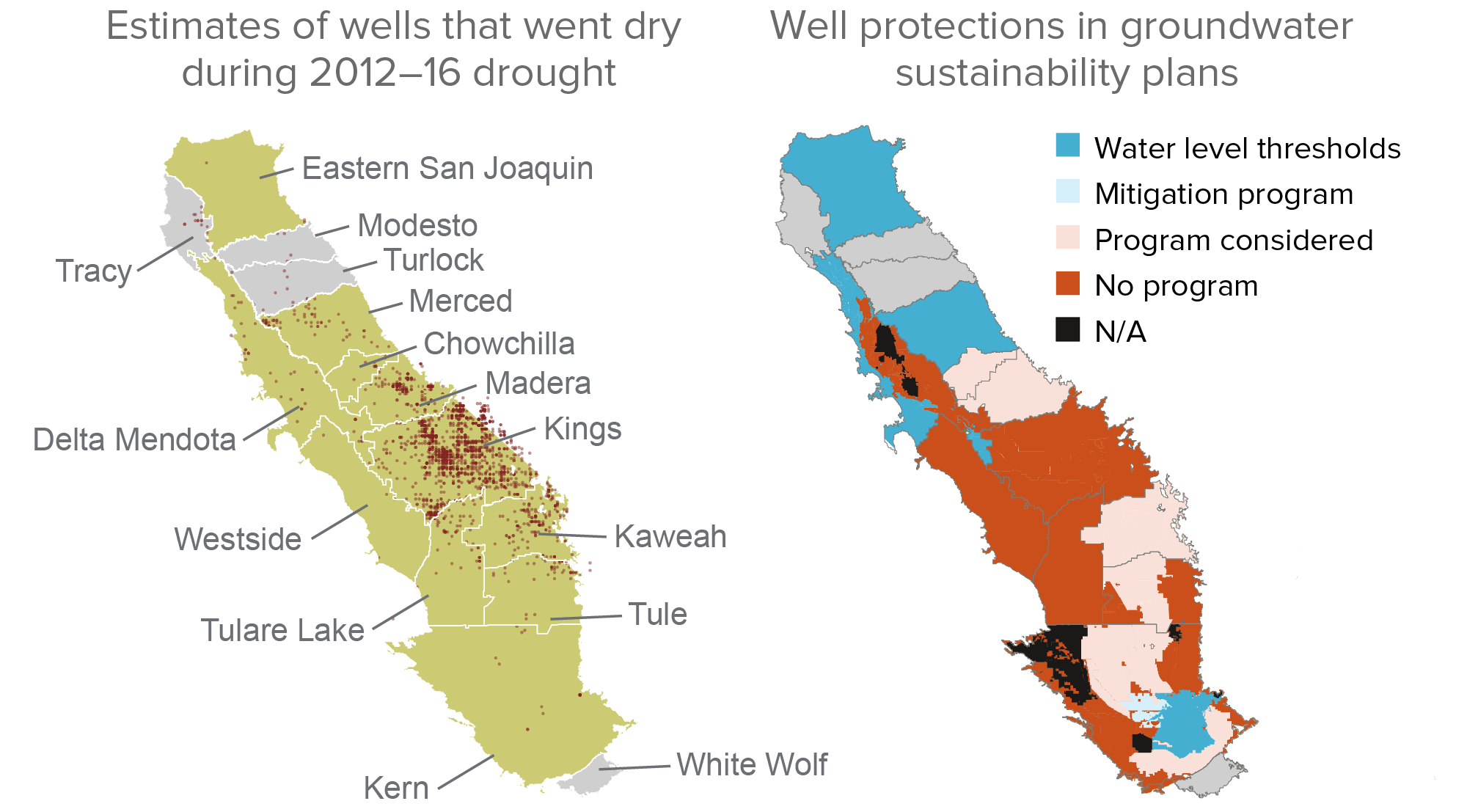
SOURCES: Jezdimirovic et al. (2020). 2012–16 dry domestic wells: author estimates based on well completion records and groundwater elevation data downloaded from the Department of Water Resources. Domestic well protections: author estimates based on groundwater sustainability plans submitted to the Department of Water Resources.
NOTES: Dry domestic wells include wells built after 1981; excludes wells where groundwater elevation data are not available. Areas marked N/A have few or no domestic wells. Basins in light gray (Modesto, Turlock, Tracy, White Wolf) are not critically overdrafted and have not yet completed sustainability plans.
Agricultural pumpers—as the largest groundwater users in most areas—will need to be at the forefront in addressing this issue. But urban utilities can help address safe and reliable drinking water problems for smaller communities in at least three ways:
- Physical or administrative consolidation with a small community system, though costly, can improve water quality and reliability.
- Technical support can improve infrastructure and financial management.
- Siting recharge projects near small communities may help buffer local water tables for shallow wells.
Some urban utilities have already begun to take on this challenge. Fresno has entered consolidation negotiations with 12 surrounding small systems that either face threats from groundwater contaminants or rely on a single well at risk of drying in the event of declining groundwater levels or a power outage (Pottinger 2020). As of this writing (July 2021), consolidation appears likely with all but a few of these systems. State funding will cover most of the costs, highlighting the value of having outside funding to facilitate consolidation that advances state drinking water goals. Where feasible, similar efforts elsewhere in the valley could also help realize these goals while bridging gaps in SGMA implementation that may be difficult for local water users to address on their own.
Where consolidation is not a good option—for example, when systems are geographically isolated—technical and/or financial support for small systems can play a useful role. This support could encompass assistance and funding to address drinking water contaminants (e.g., new water treatment systems) and ongoing operations and maintenance. Larger utilities have greater administrative, financial, and planning capacity, and they can share expertise and know-how with smaller entities at little cost. Finally, urban utilities and their partners can site recharge projects near small, low-income communities to provide co-benefits by supporting groundwater levels (Marwaha et al. 2021). Project proponents will need to consider the water quality consequences of introducing surface water into subterranean drinking water sources, however. In some cases, foreign water could mobilize contaminants present below the surface.
Partnership Lessons from Elsewhere
Challenges posed by land and water use connections, and the need for multi-party solutions, are not unique to the San Joaquin Valley, nor to California. We examined management and policy strategies that parties elsewhere in the US have adopted to accommodate urban growth in the presence of groundwater sustainability challenges. Here are several key takeaways; for details, see Technical Appendix C.
Local Coordination for Shared Benefits
Neighboring communities may work together on common water management goals, jointly finance new infrastructure, co-invest in emergency water supply sources and conveyance, and manage consolidated water distribution systems. Such partnerships occur through land use planning organizations (such as the Northwest Colorado Council of Governments), regional water agencies (like Metropolitan North Georgia Water Planning District), non-profits (e.g., High Country Conservation Center in Colorado), or a joint water commission initiated by member communities (the cities of Golden Valley, New Hope, and Crystal in Minnesota).
Cities can also forge creative partnerships to increase the amount of land set aside for groundwater recharge. In central Texas, the City of San Antonio’s Parks and Recreation Department partners with land trusts to obtain easements preventing development on private lands that have high value for recharge. The city works with a regional groundwater management agency, the Edwards Aquifer Authority, to monitor these lands after easements are acquired. With the support of San Antonio’s taxpayers, these partnerships have helped protect over 160,000 acres of land from development.
Development Requirements
The development process is an often-untapped place to garner additional water savings. There are creative ways to integrate water into development approval processes, including requiring dedicated water for new developments, instituting development fees, developing water allocation policies to ensure sufficient supplies for residential growth, and creating water budgets to reinforce these policies and encourage low water use overall. In Colorado, one particularly innovative approach is the City of Aurora’s “Z-Zone” development fee—a lower fee for development that incorporates low water-use landscaping.
Creative Water Transfers
Cities are exploring inventive ways to acquire water from farms without negatively affecting communities with simple “buy-and-dry” agreements. For example, in 2009 the City of Pueblo, Colorado, purchased water shares attached to prime farmland in a nearby irrigation district. After leasing the water back to the farmers for 20 years, the city had the option to begin using it, permanently drying up productive farmland and drastically reducing the land’s value. To mitigate that outcome, Pueblo passed a “substitution of dry-up” decree that allowed landowners the flexibility to transfer water from one parcel to another. This type of transfer allows the most productive land to continue to be farmed; once restored, dried-up marginal lands generate environmental benefits, and transferring secure water rights to the best ground increases that land’s value.
From Here to There: Water and Land Use Planning Recommendations
There are many ways to alleviate the major SGMA challenges facing urban water utilities; making the most of them will require efforts from local stakeholders as well as state and federal agencies. In particular, collaborative approaches between urban utilities and other SGMA stakeholders can secure a reliable urban water supply while also facilitating SGMA implementation more broadly. Here are key opportunities for meaningful collaboration.
Urban Water Utilities
Utilities themselves have work to do to ensure SGMA compliance and a reliable water supply at affordable rates.
- Continue to make progress on water use efficiency. The valley has relatively high per-capita water use; reducing this, where cost effective, can ease the task of meeting housing targets and reduce conflict with other water users. Part of this involves working with local planners to guide water-efficient landscaping development.
- Work with local planning departments to secure protection for key recharge areas. The valley’s cities and counties have an interest in ensuring that future water scarcity does not unduly hamper economic activity (and tax receipts). Promoting “blue belt” development policies can support projects in suitable areas that increase long-run supplies and buffer groundwater tables during drought.
- Partner with agricultural water users on recharge and trading. Valley farmers have some water available for recharge; where utilities can bring complementary resources, they can improve supply reliability by expanding the scale of existing joint projects or helping to develop new ones. Water trading has helped to fill supply gaps in the past and will be an important tool in the future. Valley utilities have experience trading surface water; trading groundwater will require new allocation systems (see below).
- Carefully evaluate the ramp-down schedule being considered by GSAs within the basin. A glide path approach can help curb agricultural and regional economic losses from SGMA. But it may also enable procrastination, leading to very costly SGMA implementation at the eleventh hour. Utilities should proactively ensure that the GSAs within their basin commit to feasible implementation schedules.
- Support collaborative processes to define allocations. Agreement on volumetric pumping allocations can facilitate cooperation and improved planning. Utilities that foresee a need to recharge large amounts of water into aquifers, or to purchase groundwater assets from others, should encourage GSAs to address this question. Many smaller utilities have not begun planning in earnest for SGMA. In order to do so, utilities must understand how access to groundwater will be allocated in the future. They should learn from the lessons of previous adjudications, as well as expert opinion on how to avoid the courts (Ayres et al. 2021a; Garner et al. 2020).
- Identify nearby small communities that have unreliable access to water. Continued difficulty in these areas may complicate SGMA compliance, and it is worth considering what actions urban utilities could take to improve their conditions. An ongoing project in Fresno highlights the enabling conditions needed to undertake a municipal water service consolidation (Pottinger 2020). Recharge partnerships that improve groundwater conditions near these communities may also hold promise.
Land Use Authorities
Cities, counties, and others who can influence land use decisions should promote integrating water management considerations in those processes.
- Explicitly consider water availability in local development planning. Many general planning documents mention water supply issues, but more deliberate consideration would be useful. Land use authorities must recognize that water resources are projected to become scarcer and should develop local “show me the water” requirements or new tools to track and manage landscape water demands.
- Collaborate to identify and protect areas for recharge. While urban water utilities and agricultural water users will likely take the lead in identifying suitable areas for recharge, city and county land use planning authorities (including planning departments and commissions) can play a valuable role in protecting those areas—and permitting land uses consistent with intermittent recharge—where water is likely to be available for this purpose.
- Consider the potential for water-smart development to support farmland transitions. Urban development is a relatively high value use of the valley’s land, and it generally uses much less water per acre than irrigated farmland. Local land use authorities, GSAs, and urban utilities should explicitly consider how water-smart urban growth can support farmland transitions under SGMA in ways that benefit local and regional economies.
State Agencies
Finally, state agencies have a role to play in evaluating water planning, harmonizing land use and water policies, supporting pilot projects, and facilitating solutions for small communities.
- Review supply and demand projections in 2020 UWMPs with SGMA in mind. Many urban utilities projected large increases in groundwater supplies to meet future demands in their 2015 UWMPs, which were largely written before SGMA was finalized. In some cases, these increases were implausibly large. State agencies should critically evaluate whether projections in the 2020 round of UWMPs—which have just started to come in—are broadly consistent with SGMA mandates. Doing so will not only help prompt conversations around appropriate planning but also improve the public data made available through the UWMP process.
- Address capacity constraints for small urban utilities. Although larger utilities are generally well positioned to address the water supply planning challenges on the horizon, our conversations with smaller urban suppliers suggest that some have not begun planning for SGMA implementation. Pandemic-related complications likely have not helped. Left unresolved, complications could arise later as unforeseen constraints emerge. Small planning grants could deliver comparatively large benefits to these communities.
- Clarify how RHNA targets can be reconciled with SGMA. Higher RHNA targets—or increased pressure to meet them—should acknowledge that doing so may require new water supplies. In basins where GSAs will need to restrict groundwater pumping to meet SGMA’s sustainability requirements, the state should support launching allocation systems and groundwater markets to help resolve this tension. This will ease the process of fulfilling water supply assessments.
- Provide guidance for how local land use planning (i.e., general plans) should incorporate SGMA. Planners should explicitly acknowledge the looming groundwater management changes and their implications for feasible development. Given the state’s interest in recharge as a SGMA implementation and climate change adaptation strategy, the state may want to emphasize that general plans should integrate “blue belt” considerations.
- Support pilot programs. Negotiations over how best to close the gap between groundwater supply and demand will likely be hampered by the high degree of GSA fragmentation in the valley. Support for pilot programs that show promise of improving regional coordination, especially with regard to recharge projects, could help facilitate urban-agriculture partnerships.
- Facilitate solutions for small communities. Hundreds of small valley communities depend entirely on groundwater, and many face supply reliability risks as well as chronic water quality concerns. Local parties—including GSAs, urban utilities, agricultural water districts, and a range of entities subject to waste discharge regulations—all have roles to play in tackling these challenges. Yet the state’s proactive involvement is essential. Strong regulatory oversight can help ensure both that GSAs address potential impacts of pumping to small community wells, and that agricultural and urban dischargers do their part to address contamination of drinking water supplies. State financial, technical, and administrative support can also facilitate effective local solutions—whether through consolidation, new treatment facilities, deeper wells, or recharge programs to support drinking water supplies. Fortunately, significant state funding is now available. Active coordination among the key state agencies (State Water Board, the Regional Water Quality Control Board, and the Department of Water Resources)—working with local parties—can ensure that solutions address both supply and quality problems in the most effective ways.
Conclusion
Most urban water utilities in the San Joaquin Valley rely heavily on groundwater today, and they will face challenges adapting to new limits to pumping as the region brings overdrafted basins into balance under SGMA. Over the next two decades, total demand is likely to rise as population growth continues—and a warming climate may increase household demands. Without smart planning, projections suggest that the valley’s urban areas could face shortfalls.
Fortunately, there are solutions. The valley can make a concerted effort to build on recent reductions in per-capita water use. Continued reductions in landscape water use are likely. Utilities and city and county land use authorities can work closely with each other to integrate land use planning and water supply planning. Urban areas and agriculture can collaborate not only in trading water but also in protecting areas for recharge, which will both bolster local groundwater levels and ensure supplies available for recharge make it into the ground.
In many ways, water utilities can make progress by engaging in partnerships with other SGMA stakeholders. Whether they involve water trading with agriculture, new collaborations to develop cost-effective recharge projects, or efforts to address the needs of smaller systems and small communities, these partnerships can help resolve water supply challenges for utilities and ease SGMA implementation for all groundwater users. Taken together, these measures will help to protect the groundwater supplies that valley residents depend on for the long term.


